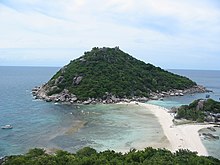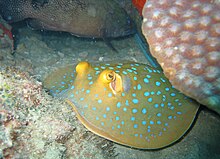Ko Tao (also often Koh Tao, Thai: เกาะเต่า, lit. "Turtle Island") is an island in Thailand located near the western shore of the Gulf of Thailand. It covers an area of about 21 km². Administratively it forms a tambon within the district (Amphoe) Ko Pha Ngan of Surat Thani Province. As at end 2006 its official population is 1382. The main settlement is Ban Mae Hat.
The economy of the island is almost exclusively centered around tourism, especially scuba diving.
Ko Tao was named by its first settlers for the island's turtle-like geographic shape. Coincidentally, the island is an important breeding ground for Hawksbill turtles and Green turtles. Development of tourism has negatively impacted the health of these grounds but a breeding program organized in 2004 by the Royal Thai Navy and KT-DOC, a coalition of local scuba diving centers has reintroduced hundreds of juvenile turtles to the island's ecosystem.
Initially the island was not inhabited, there was only the occasional fisherman from the neighboring islands, looking for shelter in a storm or just taking a break before continuing his tiresome journey.
It would appear from old maps (1600-1850) and descriptions that this island was known by European cartographers and mariners as "Pulo Bardia". The best example is a map by John Thornton dated 1685. Page 383 of 'The Edinburgh Gazetteer, or Geographical Dictionary' (1822) also mentions the island and provides a geographical position. In his book titled "Narrative of a residence at the capital of the Kingdom of Siam" by Frederick Arthur Neale (1852 p. 120) he describes the people and wildlife of Bardia. According to the account there were farms and even cows in a village on the bay lying to the west side of the island - (probably Sairee?). The book includes a fanciful illustration of 'Bardia' showing huts and palm trees.
On June 18, 1899 King Chulalongkorn visited Ko Tao and left as evidence his monogram on a huge boulder at Jor Por Ror bay next to Sairee Beach. This place is still worshiped today.
In 1933 the island started to be used as a political prison. In 1947 Khuang Abhaiwongse, prime minister at that time, pleaded and received a royal pardon for all prisoners on the island. Everybody was taken to the shore of Surat Thani and Ko Tao was abandoned again.
 In the same year Khun Uaem and his brother Khun Oh reached Ko Tao from the neighboring Ko Phangan by trying out their traditional sail boat, for that time a quite long and dangerous journey. Even though the island was still under royal patronage, it did not stop these pioneers claiming themselves a good part of the land on today's Sairee beach. Having brought their families over, they began to cultivate and harvest the excellent soil, forming the first generation of the present-day community. They lived a simple and tough life harvesting coconuts, fishing and growing vegetables, which were also traded with Ko Pha Ngan. Despite the difficulties in reaching the island, the population grew steadily.
In the same year Khun Uaem and his brother Khun Oh reached Ko Tao from the neighboring Ko Phangan by trying out their traditional sail boat, for that time a quite long and dangerous journey. Even though the island was still under royal patronage, it did not stop these pioneers claiming themselves a good part of the land on today's Sairee beach. Having brought their families over, they began to cultivate and harvest the excellent soil, forming the first generation of the present-day community. They lived a simple and tough life harvesting coconuts, fishing and growing vegetables, which were also traded with Ko Pha Ngan. Despite the difficulties in reaching the island, the population grew steadily.In the 1980s the first travelers discovered Ko Tao and their special backpacker network quickly made it widely known and a popular destination. As a consequence, bigger, faster and safer boats were used to allow easier access to Ko Tao. In the 1990s the island finally became known as a diving site.
Tourism
The island is well known for scuba diving and snorkeling. Also offers some hiking, rock climbing and bouldering. The most popular place for tourists is Sairee on the West coast, which has a white sandy beach of 1.7 km interrupted only by a few huge boulders and a scattering of medium budget resorts and restaurants. Chalok Baan Khao, to the south of the island is becoming increasingly popular as an alternative for those wishing to escape the crowds. A multitude of beautiful granite boulders, which nestle both in the forests and on the beaches of Ko Tao, attract a growing number of climbers who visit each year to enjoy the adventurous aspect of their sport.
 Ko Tao is less developed than Ko Samui and Ko Pha Ngan, but has become increasingly popular especially with the mid-20's backpacker crowd in search of relatively inexpensive scuba diving certification. For the last two years the demographics of the island has seen a age increase with many of the visitors that first visited the island over ten years ago are now for the first time returning with their families.
Ko Tao is less developed than Ko Samui and Ko Pha Ngan, but has become increasingly popular especially with the mid-20's backpacker crowd in search of relatively inexpensive scuba diving certification. For the last two years the demographics of the island has seen a age increase with many of the visitors that first visited the island over ten years ago are now for the first time returning with their families.As of December 2005, Ko Tao had about 150 resorts offering accommodation and approximately 50 bars/clubs. Most of the resorts are still bungalow-style, not hotel/resort style. As of 2007 there is a trend to more up-market resorts which do not concentrate singularly on diving. Free WiFi is provided in increasing numbers and even the first sailing charter company on Ko Tao has opened.
Ko Tao is increasingly becoming a mecca for game fishermen on a budget. Species targeted include marlin, sailfish, king mackerel, cobia, baracuda, trevally and snapper.
Diving conditions have improved dramatically in the past few years with the continuing education of locals by the dive community. The El Nino weather pattern of 1997 caused a warming of the waters which resulted in the loss of a great deal of the shallow corals near the island. Since then, the recovery has been swift and dramatic. And with help by island conservation groups the island environmental outlook is strong.
Chumpon Pinnacle, a dive site to the west of the island has a reputation for divers in search of both whale sharks and bull sharks. However, because of the warmer water temperatures over the last year a great amount of bull sharks have migrated to cooler waters.
Transportation
With few exceptions, almost all roads on Ko Tao are dirt roads and generally are in poor shape. However, new roads are being paved at a quick rate. 95% of all traffic on the island is motorbike, with mopeds and dirt bikes being the main mode of transport. Motor bike accidents are the most common injury on the island. Poor roads, sand, reckless taxi drivers and drunkenness are all a factor.
Ko Tao is serviced by ferry services from Surat Thani (4 hours day boat, 9 hours on overnight boat), Chumphon (1.5 to 3 hours), Ko Samui (approx 2.5 hours) and Ko Pha Ngan (approx 1 hour). All ferries dock at Ban Mae Haad. Journey times vary due to the different boats used by the various ferry companies. Ticket prices are almost the same for all companies, however, the boats themselves differ greatly. The two main ferries are Lomprayah and Songserm, with Seatran also offering services between the islands and mainland. Lomprayah offer the quickest service on the newest boats, and also have VIP lounges where passengers can watch movies in an air conditioned lounge. In contrast, Songserm is a no-frills point to point fast ferry, where most passengers disembark slightly more green in the face than when they boarded.
Ko Tao has no airport, so anyone wishing to fly would need to fly to Koh Samui and then transfer over on a ferry. Flights to Samui are operated by Bangkok Air and Thai Air only. Another option for flying down from Bangkok is to fly to Surat Thani, and then catch the boat over after a bus ride of 2 hours to the ferry terminal from the airport. Flights to Surat Thani are much cheaper than flights to Samui, and budget airlines such as Air Asia service the airport from Bangkok, Chiang Mai, Krabi and Phuket.
Train services are available from Bangkok down to Chumphon where travelers can then catch a ferry. A first class ticket on an overnight train, second class tickets are a little cheaper, passengers do not have the luxury of their own private cabin in second class, however, beds do pull down and once the party is over it is possible to have a good night sleep. Food is served by train vendors.
Source: http://en.wikipedia.org/wiki/Ko_Tao
Images: http://commons.wikimedia.org/wiki/Category:Ko_Tao






















